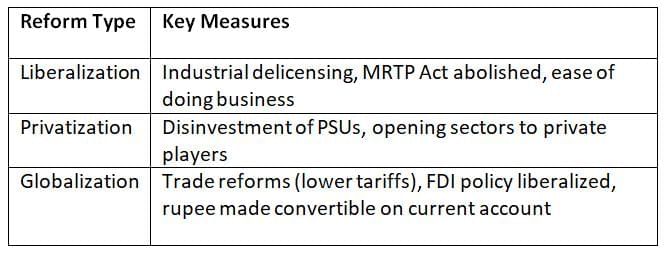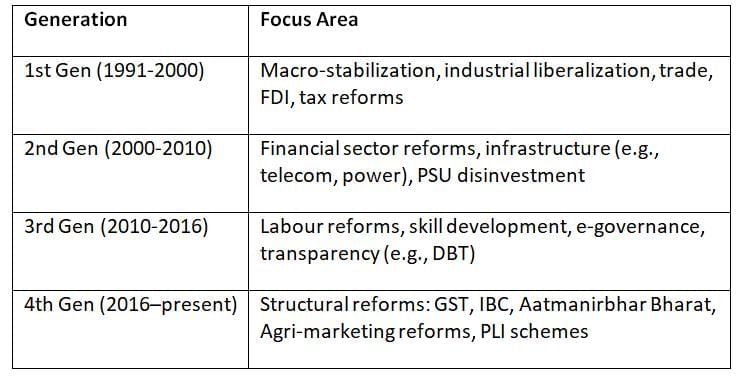UPSC Exam > UPSC Notes > Indian Economy for UPSC CSE > Cheat Sheet: Economic Reforms
Cheat Sheet: Economic Reforms | Indian Economy for UPSC CSE PDF Download
Pre-Reform Economy
- Indian economy before 1991 was state-led, inward-looking, and highly regulated.
- Features: License Raj, import substitution, public sector dominance, large fiscal deficit, low forex reserves.
Washington Consensus
Set of policy prescriptions by IMF, World Bank & US Treasury for crisis-hit economies.
Core Recommendations:
- Fiscal discipline
- Tax reforms
- Interest rate liberalization
- Competitive exchange rate
- Trade liberalization
- FDI encouragement
- Privatization
- Deregulation
- Property rights
India adopted several of these post-1991, but within a Mixed Economy framework.
Mixed Economy Model
- Combination of capitalism and socialism
- Public and private sectors coexist
- India’s post-1991 model: Retained strategic control (railways, atomic energy) but liberalized other sectors.
LPG Reforms (1991)
Initiated under PM P.V. Narasimha Rao and FM Dr. Manmohan Singh during a BoP crisis.
Generations of Economic Reforms

Disinvestment in India
Sale or liquidation of PSU shares by Government
Types:
- Minority Sale (Govt retains >50%)
- Strategic Sale (Govt gives up management control)
- Listing IPOs (e.g., LIC in 2022)
Recent Examples (2020s):
- Air India sold to Tata Group (strategic)
- LIC IPO (partial disinvestment)
New Economic Policies
- Make in India – Boosting domestic manufacturing
- Startup India – Promoting entrepreneurship
- Digital India – Tech-led governance
- National Monetization Pipeline (NMP) – Monetizing brownfield assets
- PM Gati Shakti – Infrastructure coordination
- PLI Scheme – Boosting domestic manufacturing across sectors
- Labour Codes – Consolidated 29 laws into 4 codes
- National Logistics Policy (2022) – To improve cost-efficiency
Challenges in Reform Path
- Populist resistance (e.g., farm laws rollback)
- Federal tensions (GST compensation)
- Regulatory delays and judicial overreach
- Income inequality and jobless growth concerns
Recent Case Studies & Examples

The document Cheat Sheet: Economic Reforms | Indian Economy for UPSC CSE is a part of the UPSC Course Indian Economy for UPSC CSE.
All you need of UPSC at this link: UPSC
|
108 videos|425 docs|128 tests
|
FAQs on Cheat Sheet: Economic Reforms - Indian Economy for UPSC CSE
| 1. What were the main characteristics of the pre-reform economy in India? |  |
Ans. The pre-reform economy in India was characterized by a closed economic system with heavy regulations and controls. It was marked by import substitution industrialization, where the government heavily regulated imports and promoted domestic industries through tariffs and quotas. The public sector played a dominant role in the economy, and there was limited foreign investment. Bureaucratic red tape and a complex licensing system hindered business operations, leading to inefficiencies and slow economic growth.
| 2. What is the Washington Consensus, and how did it influence economic reforms in India? |  |
Ans. The Washington Consensus refers to a set of ten economic policy prescriptions that were promoted for developing countries in the late 20th century, emphasizing market liberalization, privatization, and fiscal discipline. In India, the principles of the Washington Consensus influenced the economic reforms initiated in the 1990s, particularly the LPG (Liberalization, Privatization, and Globalization) reforms. These reforms aimed to open the economy, reduce state control, and encourage foreign investment, significantly transforming India's economic landscape.
| 3. What are the key components of the LPG reforms introduced in India? |  |
Ans. The LPG reforms introduced in India included three key components: Liberalization, which aimed to reduce government restrictions on the economy, allowing for greater market competition and openness to foreign trade; Privatization, which involved the divestment of state-owned enterprises and encouraging private ownership; and Globalization, which focused on integrating the Indian economy with the global market, enhancing exports, and attracting foreign investment. These reforms were pivotal in driving India's economic growth and modernization.
| 4. What challenges has India faced along its path of economic reforms? |  |
Ans. India has faced several challenges along its path of economic reforms, including socio-economic disparities, resistance from various interest groups, and the need to balance growth with inclusive development. Issues such as unemployment, rural poverty, and inadequate infrastructure have persisted. Additionally, regulatory hurdles and bureaucratic inefficiencies continue to pose obstacles to effective reform implementation. The political landscape often complicates reform efforts, as different stakeholders may have conflicting interests.
| 5. Can you provide examples of recent case studies that highlight the impact of economic reforms in India? |  |
Ans. Recent case studies highlighting the impact of economic reforms in India include the growth of the technology sector, particularly in software and information technology services, which has positioned India as a global leader in these industries. The rise of startups and entrepreneurial ventures, especially in urban areas, showcases the benefits of liberalization and access to venture capital. Additionally, reforms in the agricultural sector, such as the introduction of digital platforms for farmers, have improved market access and transparency, enhancing agricultural productivity and income.
Related Searches
















